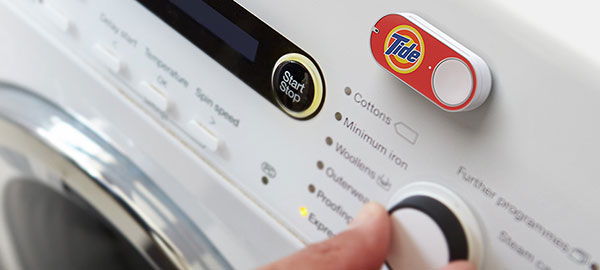Amazon on Tuesday announced a wide expansion of its Dash Button on-touch retail sales program, despite indications of relatively low acceptance among its key base of Prime customers.
The company added more than 50 retail products to its lineup of Dash thumb-drive size buttons, which let consumers reorder things like detergent and toilet tissue when their supply is getting low.
“This expanded brand list is a result of Dash Button’s growing popularity,” said Amazon spokesperson Katie McFadzean.
“Over the last three months, total Dash Button orders grew 70 percent and order frequency doubled: Amazon is now seeing two orders placed per minute from the devices,” she told the E-Commerce Times.
Amazon last year launched the Dash Replenishment Service as a means of letting Prime customers make repeat purchases of highly used products with just the touch of a button. The program initially offered buttons for products from Whirlpool, Brita and Brother.
By fall, it had expanded the lineup to include General Electric, Samsung, Petnet and other brands, letting customers replenish laundry supplies, printer cartridges and dog food, among other items.
The program expanded to more than 100 product categories earlier this year, with Amazon adding Dash buttons for Doritos chips, Energizer batteries, Clorox cleaning products, Brawny paper towels and more.
In Too Deep
Questions have been raised about the wisdom of expanding the program at such a rapid pace.
The majority of customers who have bought Dash buttons actually haven’t bought into the program, The Wall Street Journal reported earlier this week, citing data from Slice Intelligence.
Only 48 percent of those who bought a button actually pressed it to place a reorder, Slice Intelligence spokesperson Jaimee Minney confirmed to the E-Commerce Times. That figure was based on purchase data from the firm’s panel of 4 million online consumers.
Those who have used the service haven’t used it much — only making a purchase every two months or so, according to the WSJ report.
Based on those figures, Amazon appears to be investing heavily in a program that is not catching on at a pace that justifies the cost.
“Dash buttons really make no sense,” said Mike Jude, a program manager at Stratecast/Frost & Sullivan.
“They are a dedicated transaction enabler. They only work for one product, and there is little security in the system,” he told the E-Commerce Times.
Home Decor
Most customers are not going to be thrilled at the idea of sticking Dash buttons all over the house, Jude pointed out.
The buttons are small WiFi receptor devices, similar in appearance to refrigerator magnets, that customers are expected to place in strategic locations.
“First, it clutters the home — and secondly, there are few commodities that warrant a dedicated transactional point,” Jude said. “Combined with security concerns, it is no wonder that most people don’t want them.”
Amazon already has a separate program for customers who want to make automatic repeat purchases of items such as dog food and other supplies that require regular replenishment. It offers discounts on products scheduled for shipment on prearranged dates.
Automatic Button Pusher?
Amazon for many years has aimed to reduce costs and control the supply and distribution chain of the products it sells. It has taken over as the most powerful online retailer in the United States, putting enormous pressure on leading department store chains, big box retailers and rival e-commerce sites.
Still, there are incremental steps that are critical for Amazon to undertake in order to create a more efficient and cost-effective means of shipping goods to its best customers, suggested Rob Enderle, principal analyst at the Enderle Group.
The goal, in theory, is to make it easier for customers to have a rapid replenishment system for supplies they really need on a regular basis.
“The idea has merit, but habits are really hard to break,” Enderle told the E-Commerce Times. “Often, when you run out of something, you don’t have several days to wait to get a refill. Ideally this should be all automatic — as you get close to the end of something, it auto orders for you — but we aren’t there yet.”























































As a Prime customer I had to ask myself why do I need Dash buttons when I could easily schedule reorders for common products or have plenty of devices that I can use. It begs the question, how many ways does a person need to order products? Amazon to me has too much emphasis on being obsessed with using technology for selling common goods. When basically all consumers care about is a good price and fast delivery.